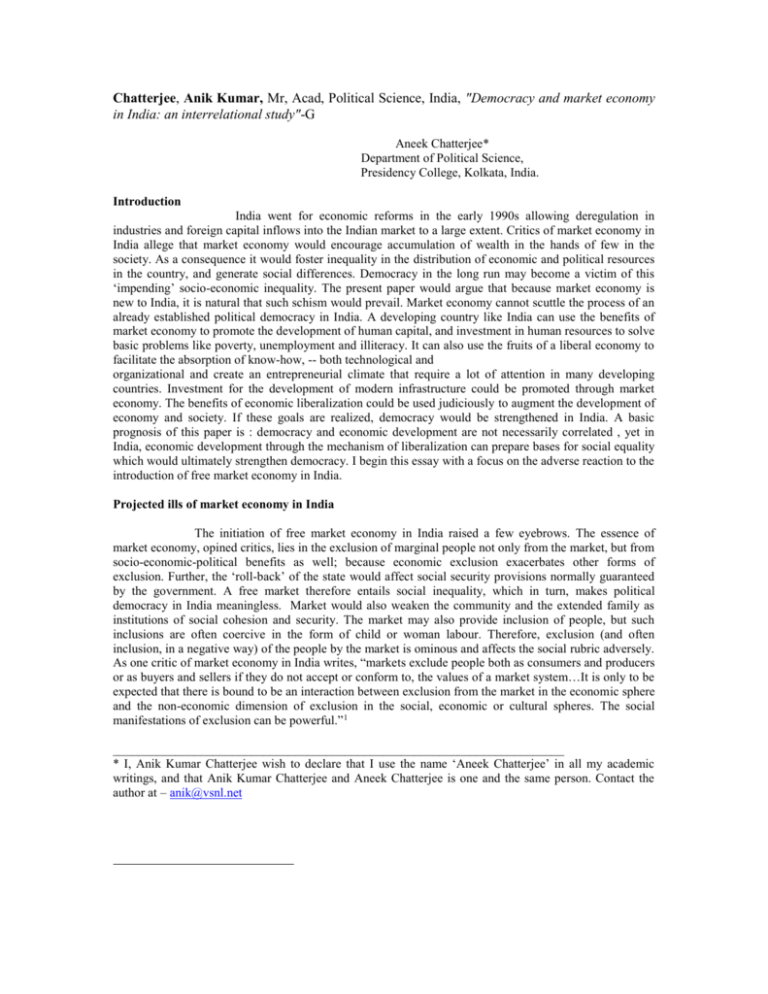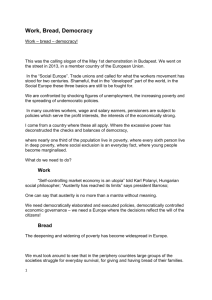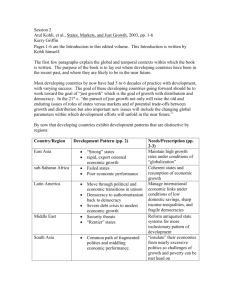Democracy and Market Economy in India : An - Pekea-fr
advertisement

Chatterjee, Anik Kumar, Mr, Acad, Political Science, India, "Democracy and market economy in India: an interrelational study"-G Aneek Chatterjee* Department of Political Science, Presidency College, Kolkata, India. Introduction India went for economic reforms in the early 1990s allowing deregulation in industries and foreign capital inflows into the Indian market to a large extent. Critics of market economy in India allege that market economy would encourage accumulation of wealth in the hands of few in the society. As a consequence it would foster inequality in the distribution of economic and political resources in the country, and generate social differences. Democracy in the long run may become a victim of this ‘impending’ socio-economic inequality. The present paper would argue that because market economy is new to India, it is natural that such schism would prevail. Market economy cannot scuttle the process of an already established political democracy in India. A developing country like India can use the benefits of market economy to promote the development of human capital, and investment in human resources to solve basic problems like poverty, unemployment and illiteracy. It can also use the fruits of a liberal economy to facilitate the absorption of know-how, -- both technological and organizational and create an entrepreneurial climate that require a lot of attention in many developing countries. Investment for the development of modern infrastructure could be promoted through market economy. The benefits of economic liberalization could be used judiciously to augment the development of economy and society. If these goals are realized, democracy would be strengthened in India. A basic prognosis of this paper is : democracy and economic development are not necessarily correlated , yet in India, economic development through the mechanism of liberalization can prepare bases for social equality which would ultimately strengthen democracy. I begin this essay with a focus on the adverse reaction to the introduction of free market economy in India. Projected ills of market economy in India The initiation of free market economy in India raised a few eyebrows. The essence of market economy, opined critics, lies in the exclusion of marginal people not only from the market, but from socio-economic-political benefits as well; because economic exclusion exacerbates other forms of exclusion. Further, the ‘roll-back’ of the state would affect social security provisions normally guaranteed by the government. A free market therefore entails social inequality, which in turn, makes political democracy in India meaningless. Market would also weaken the community and the extended family as institutions of social cohesion and security. The market may also provide inclusion of people, but such inclusions are often coercive in the form of child or woman labour. Therefore, exclusion (and often inclusion, in a negative way) of the people by the market is ominous and affects the social rubric adversely. As one critic of market economy in India writes, “markets exclude people both as consumers and producers or as buyers and sellers if they do not accept or conform to, the values of a market system…It is only to be expected that there is bound to be an interaction between exclusion from the market in the economic sphere and the non-economic dimension of exclusion in the social, economic or cultural spheres. The social manifestations of exclusion can be powerful.” 1 ________________________________________________________________________ * I, Anik Kumar Chatterjee wish to declare that I use the name ‘Aneek Chatterjee’ in all my academic writings, and that Anik Kumar Chatterjee and Aneek Chatterjee is one and the same person. Contact the author at – anik@vsnl.net The major arguments of the critics of market economy in India could be summarized, for a succinct analysis, as follows : (1) markets may exclude some people from economic participation. (2) This economic exclusion may exacerbate socio-political-cultural exclusion for these people and may deny them civil or political rights. (3) The ‘roll-back’ of the state would deprive people of social security, normally provided by the government. (4) Markets would destroy the community and the extended family, considered as significant institutions of social security in India. (5) Markets may bring coercive inclusions of people in the form of women and child labour. (6) Market economy creates inequality and therefore, affects the principles of democracy. All these arguments are however not free from defects. To begin with, no economy, state-controlled, capitalist, mixed or subsidized, can include all sections of the people all the time. In the case of India, the pre-reform ‘mixed economy’ (from 1947 to the early 1990s) left a vast section of the marginal people outside its reach, as it could not ensure their participation. As a result poverty and social inequality persisted. As two noted economists observed, “Four decades of allegedly ‘interventionist’ planning did little to make the country literate, provide a wide-based health service, achieve comprehensive land reforms, or end the rampant social inequalities that blight the material prospects of the underprivileged”2. Therefore, the schism that market economy would exclude people and exacerbate inequality cannot instill a new sense of fear in the Indian mind because for over four decades it witnessed rampant poverty and absence of distributive justice in the socio-economic sectors. In an era of globalization, market has the potential of a vast ‘reach’, as well as a boon for society if it is judiciously controlled and used. This brings us to the role of the state in an era of free market economy. Nowhere in the world market economy can operate exclusively outside government control. According to one leading American scholar, national, state, and local governments in the United States intervene in the economy in ways too numerous to list.3 If this is the situation in the United States, the apostle of market economy in the world, indications of a ‘roll-back’ of the state in India are not tenable. In fact the state in India is very much visible not only in the economic sector, but in the social and cultural sectors as well. A bit of a ‘roll-back’ would indeed be welcome as far as the Indian state is concerned. The state in India must forget to play the role of an interventionist, and instead, view it as a ‘catalytic’ state. Catalytic states try to achieve their goals less by relying on their own resources than by assuming a dominant role in a combination of states, multinational corporations and private sector groups. 4 The state in India must play the role of a controller and ensure that the markets are contestable and a major part of the resources generated from the market is directed towards social development. In third world countries like India, as elsewhere, the state must learn to adapt fast to the demands of globalization. Therefore, a complete ‘roll-back’ of the state in India is not an imminent possibility in the wake of a free market economy, the state’s role, on the other hand, could be crucial in the changing scenario. The argument that the market in India would destroy community and extended family does not correspond to the times of free economy. In fact community and extended family in India started to decline with the onset of modernization that preceded the era of market economy. Modernization in India, I believe, started in its truest sense, after India became independent in 1947. Since the mid-1950s, the process of modernization was accelerated in India with the setting up of modern industries, mainly under the guidance of the Indian state. Western education arrived in India during the British rule. The colonial masters encouraged western (mainly English) education, to create an English-knowing clerical cadre, and also to instill western cultural ethos into the Indian society. Though sporadic urbanization was effected during the British rule in India, massive industrialization was mainly created by the independent Indian state. With industrialization, started the migration of rural and semi-urban people to the modern industrial urban sectors. This process, started in the late 1950s, continued throughout the 60s up to the 80s and beyond. The decline of the traditional village-based Indian family as a cohesive integral unit started with rapid migration to the industrial cities. Members of the family, especially the younger ones, flocked to the industrial areas in search of jobs. The impervious Indian family began to get disunited from this time. I 2 would cite another cause, which I believe, affected the extended family system in India. The ‘family planning programme’ undertaken by the Indian state, effectively since the early 1960s, with emphasis on two children per family, dealt a severe blow to the notion of a large cohesive Indian family. This programme gradually replaced the large extended Indian family with much smaller nuclear family. Now it is a family of four (or three) with parents and two (or one) child(ren). The sense of cohesion and security the extended family (with grandfather, grandmother, uncles, aunts, parents and children living under one roof) provided, could not be found in the nuclear family, especially so for the children where both the parents were working. The nuclear family was an established norm in urban, semi-urban, and even in rural areas of India by the mid-1980s. And when children of the nuclear family migrated to different parts of India in search of jobs, the family got further estranged. Therefore, the decline of the impregnable Indian family was very much visible by the mid-1980s; and this happened before the onset of free market economy in India. Market liberalization therefore, has no role to play in the metamorphosis of the Indian family, because the family went through dramatic changes before the introduction of free market economy in India. The apprehension of the critics mainly emerged due to, what I believe, a ‘wrong notion’ of the suzerainty of the free market. The market has been viewed (by the critics) as a sweeping force that has the potential to destroy all socio-political-cultural moorings in India. It is precisely here that I wish to raise my objections. Free market economy in India must not be viewed negatively, -- as the all-conquering demon that would unsettle the socio-cultural fabric of India. I, on the contrary believe, that market economy in India has to live and sustain on the strengths of Indian socio-cultural-political values. The market can never ignore Indian society, politics and culture, market is not that sovereign; nor can it operate exclusively outside the control of the Indian state. As I wrote earlier, the role of the state is very crucial in India vis-à-vis market liberalization. It must create all the conditions and infrastructures for a free market, yet act as a watchdog to rein the market, as well as try to reap benefit from the market. A liberalized market could prove to be immensely beneficial for third world countries like India. I discuss below the positives of free market economy for India. Market economy and socio-economic development in India In the very first paragraph of this essay, I outlined the potential benefits a market economy can bring to the third world countries like India. In order to avoid being repetitive, I concentrate on hard data to illustrate that Indian economy has performed much better in the post-reform period (1991 onwards) compared to the pre-reform period. India’s national income grew at around 3 percent per annum from 1947 to 1975. From 1976 to 1991, the growth rate was significantly higher, -- 5 percent per annum. From 1991 to 2000, during the post-reform era, India’s national income grew at 6.5 per cent per annum; with a bullish phase from 1994 to 1997 when the growth rate of national income stood at 7 percent. 5 A well-known Indian author has shown in a significant study that growth of the Indian economy in the postreform period was much higher than in the pre-reform period, and Indian business firms responded positively towards economic reforms by going in for technological changes. 6 India’s overall exports stood at US$ 18.14 billion in 1991, and in 2001, the figure reached US$ 44.5 billion. 7 India’s foreign exchange reserves increased from US$ 1.2 billion in 1991 to US$ 55.8 billion in 2002. 8 After economic reforms, India emerged as an attractive destination for foreign institutional investors (FIIs). Investments by FIIs increased from a meager US$ 6 million in 1991 to a much respectful US$ 1.8 billion in March 2002. 9 3 The economic reforms have put greater strength and vitality in many Indian industries. Consider for example, the spectacular growth of information technology and software industries (ITSI). India’s annual software exports increased from US$ 24 million in 1985 to a staggering US$ 7.8 billion in March 2002. India’s domestic software sales increased from US$ 140 million in 1992 to US$ 2.45 billion in 2002.10 This sector has witnessed an annual growth rate of nearly 40 per cent since 1991, and software exports are estimated to reach US$ 50 billion by 2008. 11 N.R. Narayana Murthy, Chairman of the Infosys Technologies Limited, and a pioneer of the ITSI revolution in India, observed in a recent article: “The reforms proved several bureaucratic dogmas wrong… It was believed that protectionism was the only way to help the Indian industry grow. On the contrary, the entry of multinationals into India created a competitive environment that forced Indian companies to successfully adopt world-class infrastructure, quality processes, human resources practices, and so forth.” 12 Murthy has stated in clear terms that the economic reforms have proved to be a boon for the ITSI and other industries in India. 13 A skeptic mind may still ponder over the consequences of the spectacular rise of the ITSI for the development of the people at large in India, because the ITSI is not considered a labour-intensive sector. Presently, more than half a million people are employed in this sector. This is not a small number. A study carried out by NASSCOM-McKinsey suggests that employment in this sector will grow to 3 million by the year 2010.14 This figure does not include employment in the IT-based sectors such as call centers and data-processing units. The IT-based sectors are growing more rapidly than the IT sector itself, and has the potential to generate more employments than the IT sector. One positive development of the rapid growth of the IT-based sectors is that the employments generated in these sectors are not always meant for the higher educated professionally qualified people. Persons with a simple graduate degree or below are getting employment in these sectors. Therefore, the IT and IT-based sectors have already generated employment opportunities in India; and are likely to promote more employments in future. This is definitely a boon for a country like India where unemployment remained an intriguing social problem since India’s independence in 1947. A closely related problem in India has been poverty. Market economy has the potential, I believe firmly, to address this problem as well. In fact survey data show that poverty is on the decline in India. A recent non-government study projects very clearly that poverty fell in India in 1999. According to this study, the percentage of people below the poverty line came down to 30.2% and 24.7% respectively in rural and urban areas.15 The census data published by the government of India (2002) shows that the rate of literacy has risen from 52% in 1991 to 65% in 2001. Though the rate of poverty and illiteracy remain too high to be complacent, it is heartening to note that they are declining. The obvious question however would be: what is the role of market economy in this decline of poverty and illiteracy in India? Several significant empirical studies in recent years have shown that economic reforms in India have contributed to economic growth and caused a subsequent decline in poverty.16 Annual per capita growth in India rose to around 3 per cent per year in the 1990s from less than 1 per cent per year from the 1960s up to the 1980s. As economists pointed out, “ this implied about a onethird increase in consumption per capita over the last decade and a 5 to 10 percentage point reduction in national poverty rates…”17 Studies have also shown that non-farm growth has propelled agricultural 4 productivity to contribute towards poverty reduction. These growths were the outcome of the economic reform policies.18 Reduction in the level of poverty helped literacy rate to go up simply due to the fact that people staying above the poverty line felt encouraged to send their children to school. Economic reforms in India therefore contributed not only towards economic growth, but growth in the social sectors as well. Since I believe that rejuvenated social sectors would also help to strengthen democracy, I now proceed to analyze the relations between market economy and democracy in India. Market economy and democracy in India It is never easy to ascertain the relationship between forms of government and economic development. Studies claiming to have found such a relationship, as also refuting the existence of such a relationship, could be identified among academic discourses. Without moving deep into this theoretical debate, I wish to put forward the argument that market economy in India would ultimately strengthen democracy in the country. Democracy, unlike many other third world countries, is rooted in the cultural values of the Indians. The introduction of market economy in India would further strengthen these values in favour of democracy. By these ‘cultural values’ I simply mean the belief of the average Indians that pluralistic social institutions and opinions must exist, and authoritarianism must be resisted. Market economy would help to boost these values. As observed earlier, market economy contributed towards poverty reduction in India through economic growth. With reduction in acute poverty and improvement of living standards, people’s interests in pluralistic associations increase further. Economic growth also helps to reduce social and political conflicts. The reduction of these conflicts would provide for a congenial atmosphere where different social institutions proliferate and prosper. This proliferation of social institutions means to me, the evolution of a mature civil society that can help the state to function effectively and without authoritarianism. The civil society in India, as I have written elsewhere 19 would gradually mature with market economy, and put a restrain on the state. Democracy would benefit most from these changes. Market economy in India, therefore, is an important catalyst of all these social transformation. Market economy has already created a large middle class in India,-- considered as one of the largest in the world. This middle class is increasingly seeking autonomy, personal freedom, more education, civic and economic rights, and rule of law. Like any other middle class anywhere in the world, this middle class also wishes to conserve and promote democratic ideas and institutions. The existence of this ever-growing middle class is an additional fillip for democracy in India. With increasing purchasing powers, this middle class is also attracting more FIIs and FDIs (foreign direct investments) and helping in the economic growth of the country. Since the 1990s, the middle class in India has become more visible both as economic and social force. Besides emerging as a buying power, this class is increasingly getting involved in associational activities and social movements. Democracy as a consequence, is getting strengthened. Through deregulation of industries, abolition of the licensing system, and decentralizing many economic decisions to independent firms and individuals, economic reforms in India has hit the allpowerful state and its centralizing, authoritarian tendencies. The once-ubiquitous state is fast learning to relinquish some space for other social and economic actors. This is healthy for democracy. A centrally planned economy puts all its resources at the disposal of government officials. This makes the government officials feel that they are the superior species in the society, and offers them the scope to indulge in corruption, nepotism and authoritarianism. More than four decades of centrally planned economy has brought all these vices to India. The introduction of market economy therefore arouses hope in India that the evils of the centrally planned economy would be done away with. Market economy thrives on decentralized planning and activity. As a form and as an ideal therefore, it is closer to democracy because democracy also favours pluralism of ideas and associations. This is never a correlation oversimplified. Market economy has the potential to promote pluralistic 5 associations and ideas in society. It could therefore be a boon to democracy. On the other hand, a democratic country is more suitable, culturally, for market economy because it encourages decentralization of ideas and activities. Since democracy is firmly rooted in India, there is little reason to believe that market economy would be unsuitable for India. Democracy must not be evaluated in terms of economic achievements only, political freedoms have significance of their own. As one nobel-winning economist justifiably wrote, “Politically unfree citizens are deficient in freedom even if they happen to enjoy a high level of income, or a favorable standard of living in other respects.” 20 Democracy provides a socio-cultural base for free thoughts and movements. Market economy can make the best use of this environment of freedom and prosper. A free society after all is the best thriving arena for a free economy. Conclusion The Indian economy has gone past that critical stage where to open up means taking risks of being dumped by advanced economies. The Indian economy has shown enough resilience, despite apprehensions, to withstand the projected ‘onslaught’ of the market. Inequality did not escalate, poverty did not soar, illiteracy and unemployment did not create social conflicts, and the family was not destroyed. In fact, after the first phase of economic reforms, poverty, illiteracy and unemployment were reduced in India as data presented in earlier pages confirmed. Indian economy is now gearing up for second generation of reforms. In this phase, the economy would open up further to adjust itself to the growing demands of globalization. But transition from a closed to a more vibrant and open economy was not, and would not be painless. Market economy is not the panacea to all social problems. India has still to fight poverty, illiteracy, unemployment and other social problems. The second generation of reforms must be aimed at alleviating these social problems. The experience of the first phase of reforms would prove to be beneficial in this stupendous task. Market economy, if properly steered and controlled may help to reduce social problems, as first generation of Indian reforms demonstrated. The role of the state is very crucial here. The state must guide the market towards the benefit of the people. That should precisely be the role of the ‘limited’ state in an era of free market economy. Democracy essentially means power of the people. While civil rights and political freedoms equip people to raise their voice against governmental authoritarianism, economic freedom empowers them to protect and nurture institutions of civil society, besides contributing to the economic growth of the nation. Market economy has the potential to raise the economic standard of the people. In a country like India, where people enjoy civil rights and political freedoms, economic empowerment of the people would certainly strengthen democratic values. Economic development of the people is meaningless without political freedom; -- that only strengthens the market and ignores democracy. But in the case of India where political freedom of the people has been in existence for nearly six decades, economic empowerment of the people would further boost democracy. Market economy is all set to play a crucial role in this context in India in the foreseeable future. Notes and References 1. See Deepak Nayyar, ‘Economic Development and Political Democracy’, in Rakesh Mohan (ed.) “Facets of the Indian Economy”, New Delhi : Oxford University Press, 2002, pp. 140-141. 2. Jean Dreze and Amartya Sen, “India’s Economic Development and Social Opportunity”, Oxford : Clarendon Press, 1995, p. 78. 6 3. Robert A. Dahl, “On Democracy”, New Delhi : Affiliated East-West Press, 2001, p. 176. 4. See in this connection, Linda Weiss, “The Myth of the Powerless State : Governing the Economy in a Global Era”, Cambridge : Polity Press, 1998, p.209. 5. See Kaushik Basu, ‘Whither India? The Prospect of Prosperity’, in Romila Thapar (ed.), “India : Another Millenium”, New Delhi : Penguin Books, 2000, pp.193-205. 6. K.V.Ramaswamy, ‘Economic Reforms, Industrial Structure and Performance : The Case of Consumer Durable Goods in India’, in S. Uchikawa (ed.), “Economic Reform and Industrial Structure in India”, Tokyo : Institute of Developing Economies, 2001, pp.95-117. 7. Source : “Economic Survey of India : 2001-2002”, New Delhi : Ministry of Finance, Govt. of India. 8. Source : “Statistical Supplement”, Mumbai : Reserve Bank of India, May 24, 2002. 9. Source : “Economic Survey of India : 2002-2003”, New Delhi : Ministry of Finance, Govt. of India. 10. See in this connection, N.R.Narayana Murthy, ‘The Impact of Economic Reforms on Industry in India : A Case Study of the Software Industry’, in Kaushik Basu(ed.), “India’s Emerging Economy : Performance and Prospects in the 1990s and Beyond”, New Delhi : Oxford University Press, 2004, p. 217. 11. Ibid. 12. n. 10, p.220. 13. n.10, pp.217-222. 14. See the “NASSCOM-McKinsey Report”, New Delhi : National Association of Software and Service Companies, 2002, pp.21-23. 15. Angus Deaton, “Adjusted Indian Poverty Estimates for 1999-2000”, as quoted in Kaushik Basu (ed.), n.10, chapter 1, p. 22. 16. See “India : Reducing Poverty, Accelerating Development”, A World Bank Country Study Report, Oxford, 2000. Also see, K.Sundaram and Suresh D. Tendulkar, ‘Recent Debates on Database for Measurement of Poverty in India : Some Fresh Evidence’, Paper delivered at the India Workshop on Poverty Measurement, Monitoring and Evaluation, New Delhi, January 11-12, 2002. Also see, Martin Ravallion, and Guarav Datt, ‘Growth and Poverty in India : What have We Learnt from the NSS?’, Paper delivered at the India Workshop…, New Delhi, January11-12,2002. Also see, Angus Deaton, and Jean Dreze, ‘Poverty and Inequality in India : A Re-examination’, Mumbai : Economic and Political Weekly, Sept. 7, 2002. 17. Manuela Ferro, David Rosenblatt, and Nicholas Stern, ‘Policies for Pro-poor Growth in India’, In Kaushik Basu(ed.), n.10., p.153. 18. Ibid. 19. Aneek Chatterjee, ‘Civil Society, Democracy and the State : The Indian Debate and Beyond’, in Aneek Chatterjee(ed.), “Indian Parliamentary Democracy in Transition”, Kolkata : Presidency College, 2005, pp.206-218. 20. Amartya Sen ,‘Democracy and Secularism in India’, In Kaushik Basu (ed.), n.10, p.37. 7







